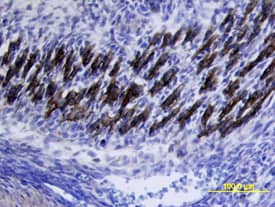Recombinant Mouse VLDLR (Ser297) Protein, CF Summary
Product Specifications
Thr25-Ala798, with a C-terminal 10-His tag
Analysis
Customers also Viewed
Product Datasheets
Carrier Free
CF stands for Carrier Free (CF). We typically add Bovine Serum Albumin (BSA) as a carrier protein to our recombinant proteins. Adding a carrier protein enhances protein stability, increases shelf-life, and allows the recombinant protein to be stored at a more dilute concentration. The carrier free version does not contain BSA.
In general, we advise purchasing the recombinant protein with BSA for use in cell or tissue culture, or as an ELISA standard. In contrast, the carrier free protein is recommended for applications, in which the presence of BSA could interfere.
2258-VL
| Formulation | Lyophilized from a 0.2 μm filtered solution in PBS. |
| Reconstitution | Reconstitute at 100 μg/mL in sterile PBS. |
| Shipping | The product is shipped at ambient temperature. Upon receipt, store it immediately at the temperature recommended below. |
| Stability & Storage: | Use a manual defrost freezer and avoid repeated freeze-thaw cycles.
|
Background: VLDLR
VLDL R is a 130 kDa type I transmembrane protein in the LDL receptor family that plays a significant role in lipid metabolism and in nervous system development and function (1, 2). Mouse VLDL R has a 774 aa extracellular domain (ECD) (aa 25 ‑ 798) and a 54 aa cytoplasmic domain. The ECD contains eight LDLR class A repeats, three EGF‑like domains, six LDLR class B repeats, and a juxtamembrane region that is rich in O‑linked glycosylation (3, 4, 5). The cytoplasmic domain contains one NPXY internalization motif. Mouse VLDL R has at least one 105 kDa alternative splice form. This variant (termed type II VLDL R) shows an Arg substitution for aa 751 ‑ 779, and has been associated with endothelial cells (5, 6). The VLDL R expressed here corresponds to a polymorphic form that shows a Cys at position 297 of the precursor. This generates a disulfide bond in the 7th LDL class A domain that is not present when position 297 is occupied by Ser (SwissProt # P98156). The 7th domain is suggested to be a critical determinant of apoE binding to VLDL R (7). VLDL R is predominantly expressed in striated muscle, adipose tissue, brain, and endothelial cells lining capillaries and small arterioles (3, 4, 8, 9). VLDL R participates in the tissue uptake of fatty acids from plasma by mediating the internalization of ApoE‑containing lipoparticles (i.e. VLDL, beta ‑VLDL, and chylomicron remnants) (8, 10). VLDL R binds and internalizes lipoprotein lipase (LPL) and mediates its transport from the basolateral to the lumenal face of endothelial cells (9, 11). VLDL R knockout mice are characterized by reduced LPL activity, reduced serum triglyceride clearance, and a resistance to developing obesity (10, 12, 13). VLDL R influences breast cancer cell motility by mediating the uptake of uPAR‑PAI1 complexes (9, 14). Lipoprotein accumulation via macrophage VLDL R is instrumental in promoting the formation of atherosclerotic plaques (15). In the nervous system, VLDL R and ApoE R2 interactions with reelin are critical for neuronal migration and positioning in the developing brain (16). VLDL R also functions in adult hippocampal synapse maturation, synaptic plasticity, and memory formation (17, 18). The ECD of mouse VLDL R shares 95% aa sequence identity with human and rat VLDL R. Within shared regions, mouse VLDL R shares 55% and 53% aa sequence identity with ApoE R2 and LDL R, respectively.
- Qiu, S. et al. (2006) Neurobiol. Learn. Mem. 85:16.
- May, P. et al. (2005) Cell. Mol. Life Sci. 62:2325.
- Gafvels, M.E. et al. (1994) Endocrinology 135:387.
- Oka, K. et al. (1994) Eur. J. Biochem. 224:975.
- Martensen, P.M. et al. (1997) Eur. J. Biochem. 248:583.
- GenBank Accession # NP_001154892.
- Ruiz, J. et al. (2005) J. Lipid Res. 46:1721.
- Wyne, K.L. et al. (1996) Arterioscler. Thromb. Vasc. Biol. 16:407.
- Argraves, K.M. et al. (1995) J. Biol. Chem. 270:26550.
- Goudriaan, J.R. et al. (2001) Arterioscler. Thromb. Vasc. Biol. 21:1488.
- Obunike, J.C. et al. (2001) J. Biol. Chem. 276:8934.
- Yagyu, H. et al. (2002) J. Biol. Chem. 277:10037.
- Goudriaan, J.R. et al. (2004) J. Lipid Res. 45:1475.
- Webb, D.J. et al. (1999) J. Biol. Chem. 274:7412.
- van Eck, M. et al. (2005) Atherosclerosis 183:230.
- Jossin, Y. et al. (2004) J. Neurosci. 24:514.
- Niu, S. et al. (2004) Neuron 41:71.
- Weeber, E.J. et al. (2002) J. Biol. Chem. 277:39944.
Citation for Recombinant Mouse VLDLR (Ser297) Protein, CF
R&D Systems personnel manually curate a database that contains references using R&D Systems products. The data collected includes not only links to publications in PubMed, but also provides information about sample types, species, and experimental conditions.
1 Citation: Showing 1 - 1
-
PCSK9 is not involved in the degradation of LDL receptors and BACE1 in the adult mouse brain.
Authors: Liu M, Wu G, Baysarowich J
J. Lipid Res., 2010-05-07;51(9):2611-8.
Applications: Western Blot
FAQs
No product specific FAQs exist for this product, however you may
View all Proteins and Enzyme FAQsRecombinant Proteins
Reconstitution Buffers
Reviews for Recombinant Mouse VLDLR (Ser297) Protein, CF
There are currently no reviews for this product. Be the first to review Recombinant Mouse VLDLR (Ser297) Protein, CF and earn rewards!
Have you used Recombinant Mouse VLDLR (Ser297) Protein, CF?
Submit a review and receive an Amazon gift card.
$25/€18/£15/$25CAN/¥75 Yuan/¥2500 Yen for a review with an image
$10/€7/£6/$10 CAD/¥70 Yuan/¥1110 Yen for a review without an image





